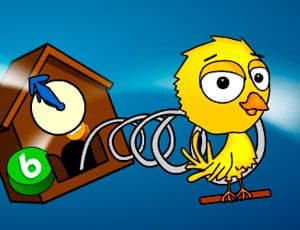Escola Games | Jogos Educativos
https://www.escolagames.com.br
Teacher's support sheet

Telling Time
Adjust the hands of the clock to the correct time.
Score points to play inside the clock!

Teacher's tips
Level of Education: Elementary School
Série: 1º Ano - 2º Ano - 3º Ano
Age: 06 to 09 years old
Subjects: Mathematics
Telling time is much more than a simple math equation. Teaching to tell time is valuable because it helps students manage their time, improving their planning skills and responsibility. And now, telling time is much more fun! This game allows students to reinforce their knowledge and explore their motor skills. [FIM-DICA]
Learner outcomes
To comprehend and relate the measurement of time to the social context;
To recognize seconds, minutes, and hours;
To identify time during the day;
To learn about analogical clock;
To tell time by looking at a clock;
To understand the clock as a tool to measure time;
To look at the clock and be able to decode the fraction on time;
To participate in problem-solving situations involving time.
Teachers' goals
Present different ways of measuring time;
Show students the importance of time to help us organize our lives;
Explore the relation between an hour and a minute;
To work with the concept of fractions with the fragments of hours;
To offer situations and opportunities for students to use their knowledge in their daily lives;
To reinforce the content discussed in the classroom.
Suggestions of approaches for the teacher
(Approach 1) To make the game more meaningful, give students situations, for example:
05:25 a.m. - Jason, Paul's father, gets up to work. What time does his alarm go off?
11:40 a.m. - Every Monday Mr. McCall buys his weekly newspaper at the supermarket. What time does he usually go to the supermarket?
(Approach 2) Make a paper clock and ask students to mark the time.
(Approach 3) Ask students to make a weekly schedule representing their daily lives (what time they wake up, go to school, eat lunch, and so on.)
(Approach 4) Show students the difference between a digital and an analogical clock.
(Approach 5) Put a clock on the wall and ask students the time randomly.
(Approach 6) Print clocks without the time. Then students should draw the times.
(Approach 7) Organize the classroom in a circle and ask the following questions:
What time do you usually get up?
What time do you eat breakfast?
What time do you come to school?
What time do we have a break?
What time does school end?
What time do you usually go to bed?
(Approach 8) Show students how a sundial works. It can be an interdisciplinary project with Geography.
(Approach 9) Ask students to divide a sheet of paper in two. On one side, they should draw a sun and things that usually happen during the day. On the other side, they should draw a starry sky and things that occur at night. After that, let students talk about what they drew.
(Approach 10) Make an hourglass with students using plastic bottles and sand.
(Approach 12) Play a memory game with the hours.
More about the content
Remember to show students that you calculate time differently.
To calculate the time of a movie session, students need to understand that calculating hours, minutes, and seconds has its specificity. We do not use the decimal system. Its basis is 60, so half of one hour is 30 minutes.
It is significant to call students' attention to specific strategies to calculate time. If a movie session starts at 8:30 p.m. and takes an hour and forty-five minutes, it will end at 10:15 a.m., which is different than it would happen at a traditional addition.
You can also invite the Science and the Geography to work on a project to learn more about the sundial and even build one. To find out more about the sundial, click on the link.
